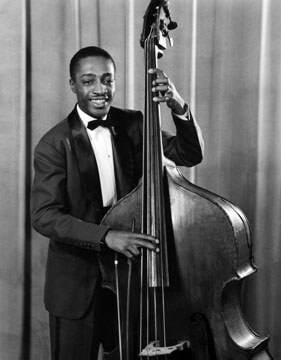December 19, 2000 – Jazz bassist and photographer Milt Hinton died in Queens, New York
Hinton’s family was born in Vicksburg, Mississippi, where he resided until age eleven when he moved to Chicago, Illinois when he was eleven. He attended Wendell Phillips High School and Crane Junior College. While attending these schools, he learned first to play the violin, and later bass horn, tuba, cello and the double bass. As a young violinist out of school, he found gainful employment as a bassist. He later recounted in interviews, released in 1990 on Old Man Time, how this prompted him to switch to double bass.
In the late 1920s and early 1930s, he worked as a freelance musician in Chicago. During this time, he worked with famous jazz musicians such as Jabbo Smith, Eddie South, and Art Tatum. In 1936, he joined a band led by Cab Calloway. Members of this band included Chu Berry, Cozy Cole, Dizzy Gillespie, Illinois Jacquet, Jonah Jones, Ike Quebec, Ben Webster, and Danny Barker.
Hinton possessed a formidable technique and was equally adept at bowing, pizzicato, and “slapping,” a technique for which he became famous while playing with the big band of Cab Calloway from 1936 to 1951. Unusually for a double bass player, Hinton was frequently given the spotlight by Calloway, taking virtuoso bass solos in tunes such as “Pluckin’ the Bass”.

As well as being a famous jazz musician, Hinton at the same time worked as a studio musician. He was part of a large group of studio musicians who played on dozens of hit records written by songwriters who worked at the Brill Building. He was responsible for the opening bass line on The Drifters’ “Under the Boardwalk” as well as playing on dozens of hits recorded by Neil Sedaka and many others.
Hinton played a rare Gofriller Double Bass during his latter career. The bass was in pieces in a cellar in Italy and a musical agent arranged the purchase from the family for Hinton. Hinton in his autobiography Bass Line described the tone as magnificent and said it was one of the reasons for his long success in the New York recording studios in the 1950s and 1960s. He later became a television staff musician, working regularly on shows by Jackie Gleason and later Dick Cavett.
Hinton twice received awards from the National Endowment for the Arts for his work as a jazz educator: a music fellowship in 1977 and an NEA Jazz Master award in 1993.
According to a search of The Jazz Discography, Hinton is the most-recorded jazz musician of all time, having appeared on 1,174 recording sessions.
Also a fine photographer, Hinton documented many of the great jazz musicians via photographs he took over the course of his career.
READ MORE:
http://www.milthinton.com/
http://www.bluenote.com/artists/milt-hinton
http://jazztimes.com/articles/20493-milt-hinton-the-judge
http://www.pbs.org/jazz/biography/artist_id_hinton_milt.htm
http://mswritersandmusicians.com/musicians/milt-hinton.html
http://www.encyclopedia.com/topic/Milt_Hinton.aspx
http://www.jazz.com/encyclopedia/hinton-milt-milton-john
http://www.britannica.com/biography/Milt-Hinton
https://www.npr.org/…/milt-hinton-the-ultimate-timekeeper
https://www.allmusic.com/…/milt-hinton…/biography
https://en.wikipedia.org/wiki/Milt_Hinton
